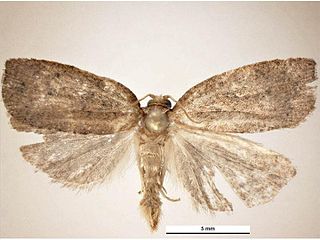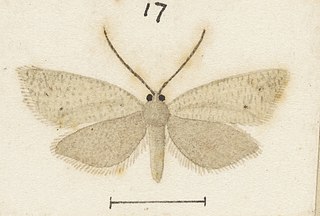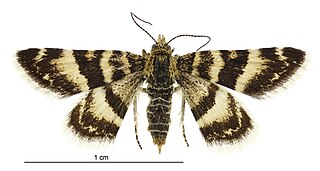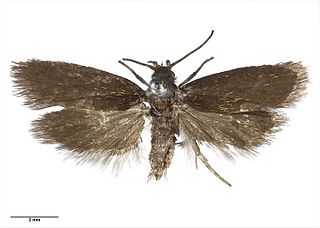
Epyaxa lucidata is a species of moth in the family Geometridae. It is endemic to New Zealand.

Planotortrix is a genus of moths belonging to the subfamily Tortricinae of the family Tortricidae.

Planotortrix excessana, the greenheaded leafroller, is a moth of the family Tortricidae. It is native to New Zealand and is an introduced species in Hawaii. It is extremely variable in appearance and feeds on many native and introduced species. It is regarded as a pest of some agricultural and forestry crops.

Planotortrix octo is a moth of the family Tortricidae. It is endemic to New Zealand, where it is found in both the North and South islands.
Planotortrix avicenniae is a species of moth of the family Tortricidae. It is endemic to New Zealand. It is found in the North Island and its larvae feed on mangrove trees.
Planotortrix puffini is a species of moth of the family Tortricidae. It is endemic to New Zealand. Specimens have been collected from Lee Bay in Stewart Island.

Planotortrix notophaea, the blacklegged leafroller, is a species of moth in the family Tortricidae. It is endemic to New Zealand. It was also present near Sydney in Australia, but this population is thought to be extinct.

Ericodesma aerodana is a species of moth of the family Tortricidae. It is endemic to New Zealand and is found in the North and South Islands. The species inhabits sand dunes and larvae feed on Pimelea prostrata. Adults are on the wing from October to January and are active at twilight. This species is classified as "At Risk, Declining" by the Department of Conservation as its larval host plant is under threat from habitat loss and the invasive to New Zealand plant, sea spurge.

Ericodesma cuneata, the Corokia leafroller moth, is a species of moth in the family Tortricidae. It is endemic to New Zealand. This moth is classified as "At Risk, Naturally Uncommon" by the Department of Conservation.
Hierodoris extensilis is a species of moth in the family Oecophoridae. It is endemic to New Zealand and is only found in Fiordland where it has been collected from Mount Titiroa and Mount Burns. It occurs in granite sand plains and gravel field habitat and has been collected in early February. As at 2012 the host plant of the larvae of this species is unknown but it has been hypothesised that the larvae may feed on plant roots given the long ovipositor of the female. This species is classified as "At Risk, Naturally Uncommon" by the Department of Conservation.

Notoreas arcuata is a species of geometer moth endemic to New Zealand. This species if found in the South Island and has been observed in the Saint Arnaud Range, around Arthur's Pass and in the Oteake Conservation Park. Larvae feed on species in the genera Kelleria and Pimelea. Adults are on the wing from December to February.

Notoreas ischnocyma is a species of moth in the family Geometridae. This species is endemic to New Zealand. This species is found in Canterbury and Otago.

Notoreas isoleuca is a species of moth in the family Geometridae. It is endemic to New Zealand.

Notoreas isomoera is a species of moth in the family Geometridae. It is endemic to New Zealand.

Notoreas ortholeuca is a species of moth in the family Geometridae. It is endemic to New Zealand.

Homoeosoma anaspila is a species of snout moth in the genus Homoeosoma. It is endemic to New Zealand. It found in the North and South Islands as well as the Kermadec Islands.
Sabatinca bimacula is a species of moth belonging to the family Micropterigidae. This species is endemic to New Zealand and has only been found in the Percy Valley and on Secretary Island in Fiordland. This species is sexually dimorphic with the male of the species having an L-shaped marking on the forewing while in the female the L-shaped marking is much broader and takes up most of the half of the forewing nearest the abdomen. The adults of this species are on the wing in the second half of October. Larvae of this species feed on the liverwort Bazzania involuta. The host species of adult S. bimacula are unknown but are likely to be fern spores or pollen from Sedge grasses. As at 2017 S. bimacula has been classified as having the "At Risk, Naturally Uncommon" conservation status under the New Zealand Threat Classification System.
Hierodoris gerontion is a moth of the family Oecophoridae. It is endemic to New Zealand and is found in the alpine zones of the mountain ranges in Central Otago. This species prefers habitat near seepages and is also common in fellfields. H. gerontion is variable in appearance with the hindwings varying in appearance from white to a darkened brownish shade. It can be distinguished from other species in the Hierodoris genus as on the second segment of the labial palpi it has sub-erect scales giving the appearance of a shaggy beard. The larvae of this species has yet to be described.
Hierodoris pachystegiae is a moth of the family Oecophoridae. It is endemic to New Zealand and has only been collected at Kaikōura. The larval host are plants in the genus Pachystegia which is found only in the Marlborough region. The larvae of this species have yet to be described from life but the adults of this species are predominantly grey in colour. The forewings of this species have silver markings similar to that of H. electrica.

Hierodoris squamea is a moth of the family Oecophoridae. It is endemic to New Zealand and is found in the mountains of Fiordland as well as the Olivine Range in south Westland. This species has a wingspan of between 12 and 13 mm and can be distinguished from similar species as it is very small in size, has a reduced eyespot on its forewings, clearly visible through Scanning Electron Microscope preparations, and has orange-yellow scales overlaying its dark forewing. It prefers open country of tussock grasslands and herbfields at high altitudes. As at 2005 the larvae is unknown. Adults are on the wing in January.














